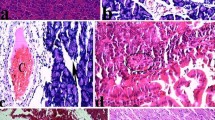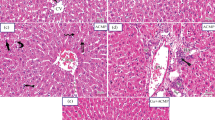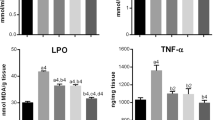Abstract
The present study aimed to analyze the impact of tartrazine (T) and crocin (Cr) applications on the pancreas tissues of the Wistar rats. A total of 40 Wistar rats were randomly divided into 4 groups with 10 rats in each group, including the Control, T, Cr, and T + Cr groups. After 3 weeks of application, the pancreatic tissues of the rats were removed under anesthesia and rat blood samples were obtained. Tissues were analyzed with biochemical and histopathological methods. It was determined that T administration increased malondialdehyde (MDA), total oxidant status (TOS), oxidative stress index (OSI), glucose, triglyceride, LDL, VLDL, and total cholesterol levels. However, it decreased reduced glutathione (GSH), total antioxidant status (TAS), superoxide dismutase (SOD), catalase (CAT), and HDL levels when compared with the other groups. It was observed that Cr administration significantly increased GSH, SOD, CAT, TAS, and HDL levels when compared with the control group. In the T group, histopathological changes were observed in pancreatic tissue, leading to damages in exocrine pancreas and islets of Langerhans and increased caspase-3 immunoreactivity (p ≤ 0.001). Co-administration of Cr and T brought the biochemical and histopathological findings closer to the control group levels. The administration of T induced damage in the pancreas with the administered dose and frequency. Cr can increase the antioxidant capacity in pancreas tissue. Co-administration of T and Cr contributed to the reduction of the toxic effects induced by T. It could be suggested that Cr administration ameliorated T toxicity.




Similar content being viewed by others
References
Abdel-Daim MM, Abushouk AI, Donia T, Alarifi S, Alkahtani S, Aleya L, Bungau GS (2019) The nephroprotective effects of allicin and ascorbic acid against cisplatin-induced toxicity in rats. Environ Sci Pollut Res Int 26:13502–13509
Abdel-Daim MM, Abushouk AI, Bahbah EI, Bungău GS, Alyousif MS, Aleya L, Alkahtani S (2020) Fucoidan protects against subacute diazinon-induced oxidative damage in cardiac, hepatic, and renal tissues. Environ Sci Pollut Res Int. https://doi.org/10.1007/s11356-020-07711-w
Abdel-Rahman HG, Abdelrazek H, Zeidan DW, Mohamed RM, Abdelazim AM (2018) Lycopene: hepatoprotective and antioxidant effects toward bisphenol A-induced toxicity in female Wistar rats. Oxidative Med Cell Longev:5167524. https://doi.org/10.1155/2018/5167524
Abdelrazek HM, Helmy SA, Elsayed DH, Ebaid HM, Mohamed RM (2016) Ameliorating effects of green tea extract on cadmium induced reproductive injury in male Wistar rats with respect to androgen receptors and caspase-3. Reprod Biol 16:300–308
Abdelrazek HMA, Kilany OE, Muhammad MAA, Tag HM, Abdelazim AM (2018) Black seed thymoquinone improved insulin secretion, hepatic glycogen storage, and oxidative stress in streptozotocin-induced diabetic male Wistar rats. Oxidative Med Cell Longev. https://doi.org/10.1155/2018/8104165
Aebi H, Bergmeyer HU (1974) Methods of enzymatic analysis. Verlag Chemie/Academic Press Inc., Weinheim/New York, pp 673–680
Altinoz E, Ozmen T, Oner Z, Elbe H, Erdemli ME, Bag GH (2016) Effect of crocin on oxidative stress in recovery from single bout of swimming exercise in rats. Gen Physiol Biophys 35:87–94
Altinoz E, Erdemli ME, Gul M, Aksungur Z, Gul S, Bag HG, Kaya GB, Turkoz Y (2018) Neuroprotection against CCl4 induced brain damage with crocin in Wistar rats. Biotech Histochem 93:623–631
Amin K, Hameid HA, Elsttar AA (2010) Effect of food azo dyes tartrazine and carmoisine on biochemical parameters related to renal, hepatic function and oxidative stress biomarkers in young male rats. Food Chem Toxicol 48:2994–2999
Bathaie SZ, Mousavi SZ (2010) New applications and mechanisms of action of saffron and its important ingredients. Crit Rev Food Sci Nutr 50:761–786
Bhatt D, Vyas K, Singh S, John PJ, Soni I (2018) Tartrazine induced neurobiochemical alterations in rat brain sub-regions. Food Chem Toxicol 113:322–327
Budwit-Novotny DA, McCarty KS, Cox EB, Soper JT, Mutch DG, Creasman WT, Flowers JL, McCarty KS Jr (1986) Immunohistochemical analyses of estrogen receptor in endometrial adenocarcinoma using a monoclonal antibody. Cancer Res 46:5419–5425
Chandra R, Liddle RA (2009) Neural and hormonal regulation ofpancreatic secretion. Curr Opin Gastroenterol 25:441–446
El Agaty SM, Ibrahim Asmaa A (2018) Pathophysiological and immunohistochemical analysis of pancreas after renal ischemia/reperfusion injury: protective role of melatonin. Arch Physiol Biochem. https://doi.org/10.1080/13813455.2018.1517182
El-Desoky G, Abdel-Ghaffar A, Al-Othman ZA, Habila MA, Al-Sheikh YA, Ghneim HK, Giesy JP, Aboul-Soud MAM (2017) Curcumin protects against tartrazine-mediated oxidative stress and hepatotoxicity in male rats. Eur Rev Med Pharmacol Sci 21:635–645
Elgawish RA, Abdelrazek HMA, Ismail SAA, Loutfy NM, Soliman MTA (2019) Hepatoprotective activity of Uncaria tomentosa extract against sub-chronic exposure to fipronil in male rats. Environ Sci Pollut Res Int 26:199–207
Elhkim MO, Héraud F, Bemrah N, Gauchard F, Lorino T, Lambré C, Frémy JM, Poul JM (2007) New considerations regarding the risk assessment on tartrazine: an update toxicological assessment, intolerance reactions and maximum theoretical daily intake in France. Regul Toxicol Pharmacol 47:308–316
Ellman GL (1959) Tissue sulfhydryl groups. Arch Biochem Biophys 82:70–77
Erdemli ME, Gul M, Altinoz E, Zayman E, Aksungur Z, Gozukara Bag H (2017) The protective role of crocin in tartrazine induced nephrotoxicity in Wistar rats. Biomed Pharmacother 96:930–935
Erdemli ME, Gul M, Altinoz E, Aksungur Z, Gul S, Gozukara Bag H (2018) Can crocin play a preventive role in Wistar rats with carbon tetrachloride-induced nephrotoxicity? Iran J Basic Med Sci 21:382–387
Erel O (2004) A novel automated direct measurement method for total antioxidant capacity using a new generation, more stable ABTS radical cation. Clin Biochem 37:277–285
Erel O (2005) A new automated colorimetric method for measuring total oxidant status. Clin Biochem 38:1103–1111
Gad El-Hak HN, Mobarak YM (2019) The neurotoxic impact of subchronic exposure of male rats to copper oxychloride. J Trace Elem Med Biol 52:186–191
Gad El-Hak HN, Mobarak YM (2020) Copper oxychloride-induced testicular damage of adult albino rats and the possible role of curcumin in healing the damage. Environ Sci Pollut Res Int 27:11649–11662
Gül M, Eşrefoğlu M, Oztürk F, Ateş B, Otlu A (2009) The beneficial effects of pentoxifylline on caerulein-induced acute pancreatitis in rats. Dig Dis Sci (3):555–563
Himri I, Bellahcen S, Souna F, Belmakki F, Aziz M, Bnouham M, Zoheir J, Berkia Z, Aziz M, Saalaoui E (2011) A 90-day oral toxicity study of tartrazine, asynthetic food dye, in Wistar rats. Int J Pharm Pharm Sci 3l:159–169
Himri I, Souna F, Aziz M, Hakkou A, Saalaoui E (2012) DNA damage induced by tartrazine in rat whole blood using comet assay (single cell gel electrophoresis). Adv Environ Biol 11:2875–2881
Hosseinzadeh H (2014) Saffron: herbal medicine of third millennium. Jundishapur J Nat Pharm Prod 9:1–2
Hosseinzadeh H, Behravan J, Ramezani M, Ajgan KH (2005) Anti-tumor and cytotoxic evaluation of Crocus sativus L. stigma and petal extracts using brine shrimp and potato disc assays. J Med Plant Res 4:59–65
Hsu SM, Raine L, Fanger H (1981) Use of avidin-biotin-peroxidase complex (ABC) in immunoperoxidase techniques: a comparison between ABC and unlabeled antibody (PAP) procedures. J Histochem Cytochem 29:577–580
Ihara Y, Toyokunı S, Uchida K, Odaka H, Tanaka T, Ikeda H, Hiai H, Seino Y, Yamada Y (1999) Hyperglycemia causes oxidative stress in pancreatic beta-cells of GK rats, a model of type 2 diabetes. Diabetes 48:927–932
Jones R, Ryan AJ (1964) The metabolism and excretion of tartrazine in the rat, rabbit and man. Food Cosmet Toxicol 2:447–452
Joudaki R, Setorki M (2019) The protective effect of Satureja bachtiarica hydroalcoholic extract on streptozotocin-induced diabetes through modulating glucose transporter 2 and 4 expression and inhibiting oxidative stress. Pharm Biol 57:318–327
Khodeer DM, Mehanna ET, Abushouk AI, Abdel-Daim MM (2020) Protective effects of evening primrose oil against cyclophosphamide-ınduced biochemical, histopathological, and genotoxic alterations in mice. Pathogens:98. https://doi.org/10.3390/pathogens9020098
Klett C, Barry A, Balti I, Lelli P, Schoenstein F, Jouini N (2014) Nickel doped zinc oxide as a potential sorbent for decolorization of specific dyes, methylorange and tartrazine by adsorption process. J Environ Chem Eng 2:914–926
Kocaman G, Altinoz E, Erdemli ME, Gul M, Erdemli Z, Gul S, Bag HG (2019) Protective effects of crocin on biochemistry and histopathology of experimental periodontitis in rats. Biotech Histochem 94:366–373
Kozłowska A, Wojtacha P, Majewski M, Równiak M (2019) The cytokine alterations/abnormalities and oxidative damage in the pancreas during hypertension development. Pflugers Arch - Eur J Physiol 471:1331–1340
Lamine JB, Boujbiha MA, Dahane S, Cherifa AB, Khlifi A, Chahdoura H, Yakoubi MT, Ferchichi S, Ayeb NE, Achour L (2019) α-Amylase and α-glucosidase inhibitor effects and pancreatic response to diabetes mellitus on Wistar rats of Ephedra alata areal part decoction with immunohistochemical analyses. Environ Sci Pollut Res Int 26:9739–9754
Lowry OH, Rosebrough NJ, Farr AL, Randall RJ (1951) Protein measurement with the folin phenol reagent. J Biol Chem 193:265–275
Mittal A, Kurup L, Mittal J (2007) Freundlich and Langmuir adsorption isotherms and kinetics for the removal of tartrazine from aqueous solutions using hen feathers. J Hazard Mater 146:243–248
Mochida Y, Fukata H, Matsuno Y, Mori C (2007) Reduction of dioxins and polychlorinated biphenyls (PCBs) in human body. Fukuoka Acta Med 98:106–113
Mohamed AAR, Mohamed WA, Khater SI (2017) Imidacloprid induces various toxicological effects related to the expression of 3β-HSD, NR5A1, and OGG1 genes in mature and immature rats. Environ Pollut 221:15–25
Mohammadzadeh L, Hosseinzadeh H, Abnous K, Razavi BM (2018) Neuroprotective potential of crocin against malathion-induced motor deficit and neurochemical alterations in rats. Environ Sci Pollut Res Int 25:4904–4914
Mohammed AT, Mohamed AAR, Ali H (2017) Pulmonary apoptotic and oxidative damaging effects of triclosan alone or in combination with fluoride in Sprague Dawley rats. Acta Histochem 119:357–363
Moshiri M, Vahabzadeh M, Hosseinzadeh H (2014) Clinical applications of saffron (Crocus sativus) and its constituents: a review. Drug Res 64:1–9
Naruszewicz M, Zapolska-Downar D, Kośmider A (2009) Chronic intake of potato chips in humans increases the production of reactive oxygen radicals by leukocytes and increases plasma C-reactive protein: a pilot study. Am J Clin Nutr 89:773–777
Nursten HE, Williams G (1969) The stability of coal tar food colours permitted in the UK. Chem Ind:1798–1803
Ohkawa H, Ohishi N, Yagi K (1979) Assay for lipid peroxides in animal tissues by thiobarbituric acid reaction. Anal Biochem 95:351–358
Poul M, Jarry G, Elhkim MO, Poul JM (2009) Lack of genotoxic effect of food dyes amaranth, sunset yellow and tartrazine and their metabolites in the gut micronucleus assay in mice. Food Chem Toxicol 47:443–448
Rios J, Recio M, Giner R, Manez S (1996) An update review of saffron and its active constituents. Phytother Res 10:189–193
Robertson RP (2004) Chronic oxidative stress as a central mechanism for glucose toxicity in pancreatic islet beta cells in diabetes. J Biol Chem 279:42351–42354
Schmidt J, Rattner DW, Lewandroski K, Compton CC, Mandavilli U, Knoefel WT, Warshaw AL (1992) A better model of acute pancreatitis for evaluating therapy. Ann Surg 215:44–56
Soares BM, Araujo TM, Ramos JA, Pinto LC, Khayat BM, de Oliveira Bahia M, Montenegro RC, Burbano RM, Khayat AS (2015) Effects on DNA repair in human lymphocytes exposed to the food dye tartrazine yellow. Anticancer Res 3:1465–1474
Sun Y, Oberley LW, Li Y (1988) A simple method for clinical assay of superoxide dismutase. Clin Chem 34:497–500
Taskin E, Guven C, Kaya ST, Sahin L, Kocahan S, Degirmencioglu AZ, Gur FM, Sevgiler Y (2019) The role of toll-like receptors in the protective effect of melatonin against doxorubicin-induced pancreatic beta cell toxicity. Life Sci 233:116704. https://doi.org/10.1016/j.lfs.2019.116704
Walton K, Walker R, Sandt J, Castell JV, Knapp AGAA, Kozianowski G, Schilter B (1999) The application of in vitro data in the derivation of the acceptable daily intake of food additives. Food Chem Toxicol (12):1175–1197
Yaribeygi H, Noroozadeh A, Mohammadi MT, Johnston TP, Sahebkar A (2019) Crocin ımproves oxidative stress by potentiating ıntrinsic anti-oxidant defense systems in pancreatic cells during uncontrolled hyperglycemia. Aust J Pharm 22:083–089
Acknowledgments
This research did not receive any specific grant from public, commercial, or not-for-profit funding agencies.
Author information
Authors and Affiliations
Corresponding author
Ethics declarations
Conflict of interest
The authors declare that they have no conflict of interest. The authors alone are responsible for the content and authoring of the present paper.
Additional information
Responsible Editor: Mohamed M. Abdel-Daim
Publisher’s note
Springer Nature remains neutral with regard to jurisdictional claims in published maps and institutional affiliations.
Rights and permissions
About this article
Cite this article
Erdemli, Z., Altinoz, E., Erdemli, M.E. et al. Ameliorative effects of crocin on tartrazine dye–induced pancreatic adverse effects: a biochemical and histological study. Environ Sci Pollut Res 28, 2209–2218 (2021). https://doi.org/10.1007/s11356-020-10578-6
Received:
Accepted:
Published:
Issue Date:
DOI: https://doi.org/10.1007/s11356-020-10578-6




